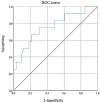Analysis of Clinical Characteristics and Severe Factors of 47 Cases of Psittacosis
- PMID: 40486920
- PMCID: PMC12145142
- DOI: 10.2147/IDR.S515416
Analysis of Clinical Characteristics and Severe Factors of 47 Cases of Psittacosis
Abstract
Purpose: Analyze the epidemiology, clinical manifestations, and imaging characteristics of 47 patients with psittacosis, combined with laboratory indicators, to explore influencing factors and early warning indicators of severe psittacosis.
Patients and methods: The analysis was conducted on case data of patients with psittacosis admitted to The Affiliated Changsha Hospital of Xiangya School of Medicine, Central South University, from January 2021 to September 2024, comparing differences between non-severe and severe patients, analyzing the correlation and impact degree between laboratory indicators and severity of the illness, finding independent influencing factors for the progression of psittacosis patients to severe.
Results: The mean age of 47 patients was 61.53. 61.70% of patients were male. Most patients were retired and self-employed (23.40%). A clear history of exposure to poultry was observed in 36.17% of patients. These were mainly associated with hypertension (31.91%), cerebral infarction (10.64%), and Acquired Immune Deficiency Syndrome (10.64%). The median time from disease onset to hospitalization was 5 days. The median length of the hospital stay was 10 days. 85.11% of patients had fever. Chest CT features were mainly pulmonary lobe infectious lesions (93.62%). Compared with non-severe patients, severe patients had higher levels of aspartate aminotransferase, lactate dehydrogenase, D-dimer, C-reactive protein, and procalcitonin (P < 0.05). LDH, D-dimer, CRP, and PCT levels positively correlated with severe psittacosis (r > 0, P < 0.05). D-dimer level was an independent risk factor for the progression of psittacosis to severe disease (OR > 1, P < 0.05), with an AUC of 0.761. The optimal threshold was 2.50μg/mL, with 66.70% sensitivity and 78.80% specificity.
Conclusion: Forty-seven patients with psittacosis were mainly elderly males, with fever as the typical symptom. Chest CT revealed infectious lesions in the lung lobes. D-dimer level could be an independent factor for the early warning of severe psittacosis.
Keywords: d-dimer; early warning; influencing factors; psittacosis; severe illness.
© 2025 Zhou et al.
Conflict of interest statement
The authors report no conflicts of interest in this work.
Figures
Similar articles
-
Psittacosis Pneumonia Features, Distinguishing Characteristics, and Outcomes: A Retrospective Study.Infect Drug Resist. 2024 Dec 11;17:5523-5533. doi: 10.2147/IDR.S482471. eCollection 2024. Infect Drug Resist. 2024. PMID: 39676850 Free PMC article.
-
[Clinical features and risk factors for secondary hemophagocytic lymphohistiocytosis in elderly patients with severe SARS-CoV-2 infection: a multicenter retrospective cohort study].Zhonghua Wei Zhong Bing Ji Jiu Yi Xue. 2023 Aug;35(8):793-799. doi: 10.3760/cma.j.cn121430-20230510-00158. Zhonghua Wei Zhong Bing Ji Jiu Yi Xue. 2023. PMID: 37593855 Chinese.
-
Clinical characteristics of 14 cases of severe Chlamydia psittaci pneumonia diagnosed by metagenomic next-generation sequencing: A case series.Medicine (Baltimore). 2022 Jun 17;101(24):e29238. doi: 10.1097/MD.0000000000029238. Medicine (Baltimore). 2022. PMID: 35713429 Free PMC article.
-
Clinical characteristics, laboratory abnormalities and CT findings of COVID-19 patients and risk factors of severe disease: a systematic review and meta-analysis.Ann Palliat Med. 2021 Feb;10(2):1928-1949. doi: 10.21037/apm-20-1863. Epub 2021 Jan 27. Ann Palliat Med. 2021. PMID: 33548996
-
Biomarkers and outcomes of COVID-19 hospitalisations: systematic review and meta-analysis.BMJ Evid Based Med. 2021 Jun;26(3):107-108. doi: 10.1136/bmjebm-2020-111536. Epub 2020 Sep 15. BMJ Evid Based Med. 2021. PMID: 32934000 Free PMC article.
References
LinkOut - more resources
Full Text Sources
Research Materials
Miscellaneous


